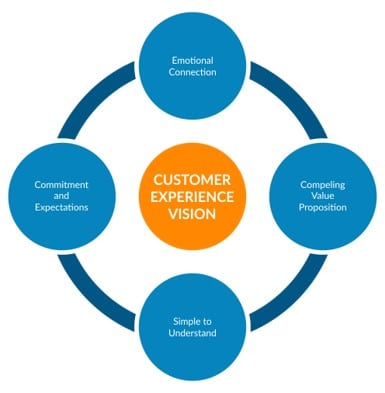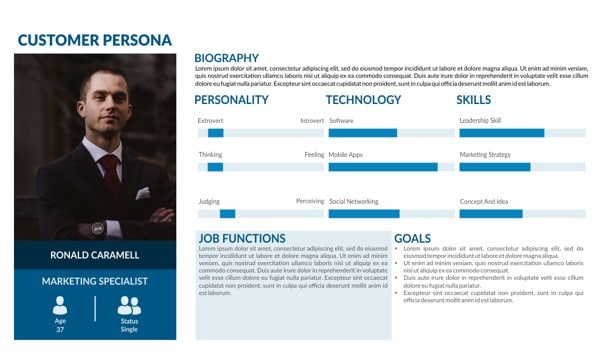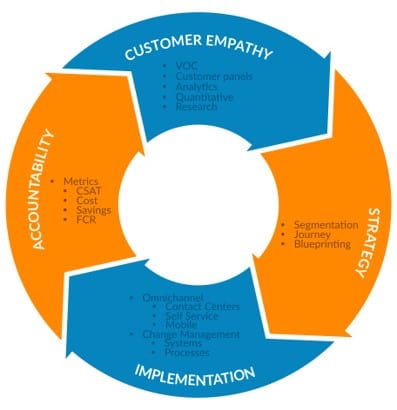Learn all about customer experience, its importance, and how to improve it through our in-depth guide and with our customer experience strategy cheat sheet.
What is Customer Experience?
There are lots of buzz words and phrases used in the business world. The customer experience (CX) is a prime example. The phrase has become ever more popular of late but is one that’s often misunderstood.
Before talking about how important it is, let’s explain the concept of the customer experience and nail down what the phrase means. In a nutshell, customer experience refers to the impression a firm or brand leaves on a customer. That is the feeling about and view of a brand that results from customer interaction.
Every touchpoint that a customer has with your firm along the customer journey generates an interaction. In combination, they contribute to their overall customer experience. Good, satisfying interactions improve customer experience, and vice versa.
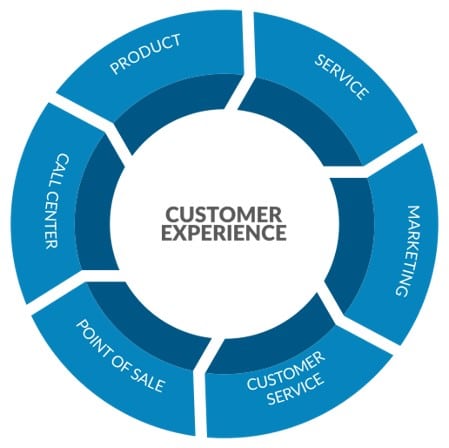
Many people are confused about the difference between customer experience and customer service. Customer experience goes beyond just good customer service behaviours and encompasses the entire customer journey. Customer service regards the support customers receive when or after buying a product. Your customer service delivery is merely one part of the wider customer experience.
Alongside customer service and customer support, the product or service you provide is the other main element of customer experience. As companies consider the importance of customer service, they should be aware that low quality or faulty products, or poor service provision naturally leads to negative perceptions of your brand.
When firms talk of how to improve customer experience, they’re often looking for a holistic approach – a way to go beyond traditional, reactive customer service. Good customer experience strategies seek to predict potential problems. One way to maximise the customer experience is to preempt issues to ensure they don’t arise. Those issues may relate to how a firm interacts with customers or how products perform.
The Importance of Great Customer Experience
The adage that the ‘customer is always right’ is one that all business owners will know. It’s easy for customers to move to your competitor if they’re dissatisfied with your service or any aspect of the customer experience. In some fields, firms and platforms exist to make the process of switching to competitors fast and efficient. Your customers also have a far greater ability to affect your brand in other ways. Social media and online reviews let them share reports of adverse experiences far and wide – colouring potential customers’ perceptions of your brand.
In the increasingly competitive market within which we operate, providing the best customer experience matters. If you’ve been wondering about why customer experience is important for a business, a recent Adobe report found that B2B firms saw customer experience as the most exciting opportunity for 2020.
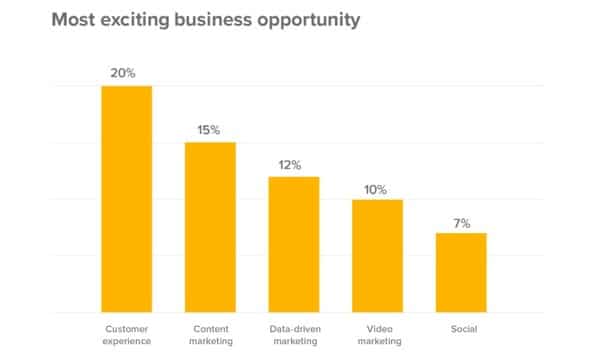
Source: Super Office
Satisfied customers, wowed by your firm, are likely to be your number one marketing resource. Happy customers are likely to make repeat purchases, recommend you to others and share stories of how they enjoyed the best customer service experience with your company. This brand loyalty can do as much good for you as an expensive marketing campaign. What’s more, those customers are also willing to spend up to 86% more for a better customer experience, showing just how valuable it can be to improve yours as a business.
It’s no wonder that firms in all niches have come around to the importance of customer experience. By focusing on how to improve customer experience, firms boost their bottom line. There are four main aspects of how good customer experience can benefit your firm’s finances.
Reinforce Brand Preference
In a competitive landscape, customers have a lot of choices. When products or services are hard to differentiate, good customer experience can be a key differentiator. It can ensure that customers choose you over your rivals. Brands that provide an exceptional customer experience inspire customer loyalty. Looking at the customer experience impact in a less positive form, 32% of consumers will abandon a brand they love after only one bad encounter.
Reduce Customer Churn
Inspiring loyalty in customers is critical to any firm’s bottom line. Lower levels of customer churn – customers leaving – helps increase profitability. It costs a lot less to retain a customer than it does to acquire new customers. Creating an ongoing customer relationship by offering a good product or service, as well as a superior customer experience, makes your buyers more likely to stick with you. That customer engagement will often continue even if other firms undercut you on price.
Inspire Customer Advocacy
Word of mouth advertising is lucrative for businesses of all types. In the modern age of social media, positive reviews and testimonials have a significant reach. A recommendation from a friend is even more powerful for creating customer engagement. Happy, loyal customers make for outstanding brand advocates. Offering memorable customer experience inspires customers to share their stories far and wide.
Increase Company Revenue
One of the most effective methods to increase profits is to focus on customer retention. Satisfied customers are more likely to purchase from you again, and will spend more on your product or services than a new customer. Their positive word of mouth recommendations can convince others to buy from you for the first time. This shows the importance of customer service and the benefits that can come as you improve customer service and the overall customer experience.
3 Successful Customer Experience Examples
The best way to improve your customer experience is by ensuring you provide the best experience across every customer touchpoint. This will cover your digital assets, how your product or service is delivered, the quality of that product or service, and customer service. All of which combined will help improve your engagement for the best customer service experience.
That’s the theory. However, there are many ways to go about achieving this goal. The following are three ultimate customer experience examples where firms excelled. The fact that these stories – from companies who understand the importance of the customer in service delivery – made it into the public domain is telling in itself. It shows how useful creating a positive customer experience was to the brands in question. Reading them will hopefully provide you with some ideas about effective customer experience strategy and best practices to elevate the customer experience you provide.
Example 1 – Tommee Tippee’s Use of Social Listening
We’ve already mentioned how you need to be proactive to provide good customer experience. You must think about your customers’ needs, meetings them before they even realise they have them. One excellent and proactive way to find out what people think of your brand is via social listening.
Tommee Tippee showed the value of social listening to customer experience in 2016. Late in that year, a desperate father shared on Twitter his need to find a very particular two-handled cup. David Carter’s autistic son would only drink from the specific cup, and it seemed to no longer be on the market. This is where Tommee Tippee embodied what customer care is all about.
Tommee Tippee was the manufacturer of the cup. The firm noticed Mr Carter’s #cupsforBen campaign. They went above and beyond simple digital customer communication, finding the original mould and committed to making a special run of 500 new cups.

Through social listening, the company delivered an excellent customer experience for one family. What’s more, the story hit the press and garnered plenty of positive attention around the world, showcasing the importance of both customer service and the customer experience in increasing brand awareness. The firm was proactive and worked hard to deliver for one customer. The story of how they did so gave a huge boost to their brand perception.
Example 2 – Vodafone’s Network Status Checker
Vodafone UK recently implemented a Network Status Checker tool. It’s an excellent example of a customer engagement platform designed to provide a better customer experience. In essence, the Status Checker is an interactive and graphical representation of network performance across the UK. It was the first of its kind in the UK telecoms market and provided one of the best customer experience examples of recent years.
Through this new customer engagement software, Vodafone was preempting customer issues. Without the tool, phone users suffering outages knew they had a problem, but didn’t understand the cause. Their only way of getting info on network-related issues via customer interaction channels was to call a contact centre. That takes time and effort and is something that many people find frustrating.
Vodafone decided that a better way of serving customers would be the creation of the status checker tool. This self-service tool elevates digital customer communication by updating in real-time, and displays both unexpected issues and planned maintenance. Users enter their location and can immediately see what issue is causing the problem.

The advantages of such a customer engagement platform to Vodafone are two-fold. Firstly, they’re improving the customer experience of those suffering network problems. It’s easier for those customers to identify what the problem is and learn when it’ll get solved. Secondly, they reduce the volume of calls to their contact centres. As such, customer service agents have more time and scope to help other customers. This is the definition of good customer service and shows that it has real meaning in improving the digital customer experience.
The tool was an excellent example of a positive customer experience and proved a significant success for Vodafone. Within a few months of launch, the firm saw a 9% reduction in network-related complaints. There were also 54% fewer escalated queries that needed a customer call back. By seeking out a new way to answer customer queries, Vodafone made real strides in improving the customer experience.
Example 3 – Netflix’s Use of Personalised Recommendations
Few companies have disrupted their industries as effectively as Netflix. The streaming service has changed the way that millions of people watch TV. Personalisation has always been at the heart of their business strategy. Netflix are proving themselves to be masters of digital experience management through personalisation, allowing them to deliver a compelling customer experience.
To achieve the level of personalisation desired, Netflix leans on machine learning. Machine learning algorithms log users’ preferences of what they like to watch. One of the most innovative customer engagement ideas of recent years is how the data that is generated is then key to create a personalised user experience.
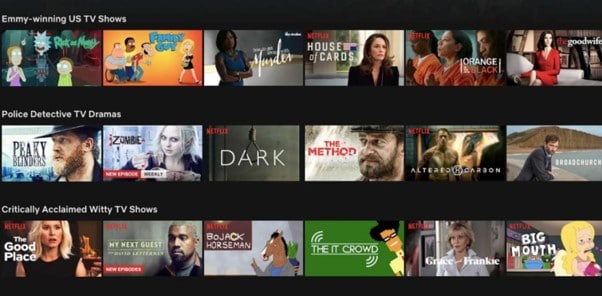
Netflix can use that data to create tailored marketing sparking unique customer engagement for each user. The firm can send recommendations of new shows that they think each user may wish to watch. When users interact with the recommendations, there’s more data to inform future marketing. This makes it not only a leading customer experience example, but also a good showcase for how best to use customer analytics.
Being able to ‘discover’ new shows is a vital part of Netflix’s appeal. Users develop a more positive view of the company based on good recommendations. Compare this to how television shows were delivered before the advent of Netflix, and it’s easy to see how this exceeded customers’ expectations.
As the digital customer experience provided by the service was so much better than traditional TV or cable, people recommended the service to their friends and colleagues. By using machine learning as part of their customer interaction channels, Netflix was able to not only improve the customer experience, but also earn loads of free advertising. They’re now leading the way in terms of digital experience trends, and a model for many to follow.
5 Ways to Improve Your Customer Experience
The above examples of high-quality customer engagement may have given you some ideas to improve the customer experience at the firm where you work. If you really want to elevate customer experience, you need to work a little harder. There’s no one customer experience strategy template that’ll work for every company. There are things that every company can do to improve customer interactions.
Good customer experience gives added value to customers through their entire journey with a brand. For that, you need to take a holistic approach that’s also customer-centric. What that means is that all areas of your business must focus on customer needs and expectations. The following are five steps towards truly valuing the importance of the customer in service delivery and providing the ideal experience for your customers.
-
Create a Customer Experience Vision
If you want to make changes to improve customer experience, you need first to define your vision. A singular, well-defined customer experience vision is vital. It can go a long way towards successfully building a customer experience team and help keep all departments and employees on the right path. According to Olive Huang, research director at Gartner, the vision is critical:
‘A customer experience (CX) initiative that lacks a strong, clear vision often fails to achieve its intended result.’
Customer experience vision examples can be as varied as the firms which develop them. The most effective do share some key attributes. First, they’re simple to understand. Your vision should convey to staff and customers just what your firm is striving to deliver.
Your vision must also succeed in generating a strong emotional connection. It can begin with asking questions like ‘what does great customer service look like’ and ‘what do customers expect from excellent customer service’, but ultimately, you want customers to truly feel that your staff – and by extension, your brand – are genuinely on their side.
A compelling value proposition has to form part of your CX vision. You need to exceed customer expectations and show how the experience you’re going to deliver sets you apart from your rivals. That way, you will both attract customers and motivate your staff, giving you a competitive advantage over others in the market.
You want your vision to create an environment where everyone pulls toward a shared goal. When defining the vision for the ideal digital customer experience, it pays to get everyone involved. A committee-based approach to building your CX vision is critical. If you bring all departments in at the outset, you’re more likely to develop, and subsequently, implement a coherent customer experience strategy. Changes that will get made end-to-end through the customer journey.
-
Define Your Customer Persona
If you’re going to focus more on customer experience, you must take a customer-centric view of your business. Everything about business operations needs to have your customers in mind. You need to understand their needs, desires, and how they interact with your brand. To gain any of those insights, you first have to understand them. That’s the importance of effective consumer relations.
Customer personas are tools to help you get a better understanding of your customers. Personas are fictional but believable representations of your typical customers. They reflect and display the attributes and characteristics that those customers share. For instance, your customer persona would include key motivations, attitudes, and pain points. It should also feature general demographic information.
Personas are vital for improving customer experience in many ways. This can include informing customer service activity ideas, innovating new types of customer service interactions and providing the best experience possible. As well as aiding understanding, personas help to put a face to your customers and identify their pain points.
On a more practical level, personas also make it easier to improve business processes. Your personas help you focus on how customers interact with your company. That makes it simpler to design or tweak processes to enhance interactions. Again, these changes can get made throughout the customer journey to help you form a clear definition of your consumer engagement.
When defining a persona, you must use as much data as possible. Market research, surveys, and social listening are all excellent sources of customer data. Drawing info from those sources will make your characterisations more accurate. Don’t forget to craft first-person narratives, though, as that is what builds empathy.
-
Capture Customer Feedback in Real-Time
To improve your customer experience, you must first know how you serve customers now. More importantly, you must understand the current customer perceptions of your brand. The best and easiest way to get that information is by asking. Customer satisfaction surveys and feedback requests are how you can get the info you need. It’s information that can be utilised to improve customer service and elevate the digital customer experience.
As with many things in life, when using customer experience surveys, timing is critical. It’s best to engage with customers while they’re interacting with your brand. Please don’t wait until after their journey with you is over. Real-time customer feedback, on topics such as different aspects of customer service and digital product experience examples, is what you should shoot for, for a variety of different reasons.
First, you’re more likely to get feedback if you ask for it in real-time. Many customers ignore survey requests from firms they bought from a while ago. That’s for the simple reason that they’ve forgotten about the interactions with the brand. Being proactive and seeking real-time feedback, too, helps to show customers that you care. That’s especially true if you act on their feedback and implement changes to areas such as your customer service attitudes and practices based on it.
What you must do is track customer behaviour and seek openings to capture feedback. Take, for example, if someone has visited your site’s pricing page a few times but not made a purchase. You could reach out in that case and ask if there’s something specific putting them off. That kind of feedback is what you can use to define and drive your customer experience vision and provide the most effective definition of customer engagement going forward.
-
Use a Quality Framework For Your Team
Defining a customer experience vision solidifies what you want to achieve. Building personas helps you understand your customers. They do fund your business, after all. Capturing feedback from those customers provides concrete ideas to improve different customer service areas and overall customer experience. It’s now time to implement your new customer experience strategy.
That strategy needs to be consistently delivered across your organisation. All departments and all staff members must be on the same page. The best way to achieve that is by creating and applying a quality framework for your team, affecting everything from customer service department objectives to the values of your consumer service centre. Such a framework lays out what’s expected of staff in delivering your vision. It’s the major planning element of customer experience management (CXM).
By using a quality framework, you can identify where each of your team members stands in terms of CXM. That makes it easier to pinpoint any training needs they may have to reach the standard you need. In turn, you can then swiftly offer extra coaching or training where required.
Your framework will create an environment where tracking the development of your team is simpler. That means you can monitor essential quality-related metrics. Many companies are familiar with techniques used to identify customer service failure and make improvements to customer service operations. These metrics also record how well your team is delivering your customer experience vision. Prime examples include things like response times, positive customer reviews, etc.
-
Measure the Customer Feedback
Improving customer experience can’t be done in a one-hit. You can’t decide to implement a new vision, make changes, and then forget about it. The answer to the question ‘what is customer experience management?’ is that it’s a process, not a one-off event. You must continually monitor how you serve your customers so you can improve.
To make those ongoing improvements, you must track and measure the impact of your efforts. You need to understand what effect any changes you make are having. The best way to achieve that is via an intelligent analysis of customer feedback, allowing you to continually improve customer service and elevate the overall customer experience.
When you deliver great customer experience, customers are more likely to recommend you. Net Promoter Score (NPS) is a metric of that likelihood of a recommendation. Measuring and tracking changes in your NPS is an excellent way to assess the impact of any new strategy.
Measuring your NPS is comparatively simple. It needs only a simple survey question that asks customers to rank how likely it is that they’d recommend you. Typically, firms provide a scale from 1-10 for the ranking.
Movements in your NPS over time will suggest the impacts of your new CX strategies. Remember, though, that customer experience encompasses the whole customer journey. As such, you need to collect your NPS at multiple touchpoints. That way, you get a holistic view of the experience you’re delivering, from your customer service principles and practices to your digital customer communication, and more.
Downloadable PDF: Ultimate Customer Experience Strategy Cheat Sheet
Do you have a customer experience problem that you’re not even aware of? Download our customer experience strategy PDF. Our comprehensive cheat sheet will help you identify customer experience issues fast.
3 Key Elements of a Digital Experience Strategy
Your digital experience strategy is how you deliver the right CX online. In this more digital world, a digital experience strategy is vital to more firms than ever before, including following the right digital product experience examples (everything from mobile apps to your online product catalogue).
Your customer journey map will have different touch points if you don’t have a brick-and-mortar location. The ways by which customers interact with you change, as well. To ensure you provide the best digital customer experience possible, you need to know the three critical elements of a digital experience strategy.
-
Omnichannel Customer Service
Connect customers with the right agents, no matter where they are. Customer relationship management needs to span every channel you’re available on. Improve customer service by resolving issues faster, giving your agents access to experts across your organisation. Implement and integrate business intelligence apps and other solutions. All of that produces a seamless customer experience across channels.
-
Proactive Customer Engagement
Ensure your staff and agents have the required tools for proactive customer engagement. Customers expect a quick follow-up to communication. This could include everything from being able to describe the functions of customer information systems to offering real-time account updates. Make it easy and quick for your staff to reach out to and interact with your customers. That guarantees speedy problem resolution. It also allows for the collection of real-time feedback and boosts overall CX.
-
Customer Engagement Across Any Channel
Efficiently manage customer interactions across every channel. In the digital world, there are far more ways for customers to contact you. Customer experience must be consistent across all those channels. Merging customer identities across channels and CRM can help you improve your digital customer experience. It lets you highlight the importance of customer service by delivering a more personalised experience.
Conclusion
Businesses must differentiate themselves from their rivals. Many modern firms seek to do so through good customer experience. Delivering superior CX is increasingly favoured as a strategy. It’s more forward-thinking than more traditional ideas targeting product or price.
Switching focus to customer experience offers an outstanding opportunity for businesses. Improving their end-to-end CX helps generate more customer loyalty and advocacy. That has a profound effect on a firm’s bottom line. That effect, in turn, explains the importance of customer experience.
To improve customer experience, you need to get all your team members on the same page. That requires a clear and concise customer experience vision. By setting out such a vision, you not only emphasise the importance of customer service, you build an emotional connection with your customers. That way, all your team members will buy into your CX strategy.
There’s no one-size-fits-all customer experience strategy template. It’s crucial to understand what CX is, why it’s important, and the key elements to improving it. That’s how you can get on the road to delivering a customer experience that sets your business apart.
Originally published May 26, 2020, updated Jan 17, 2023

